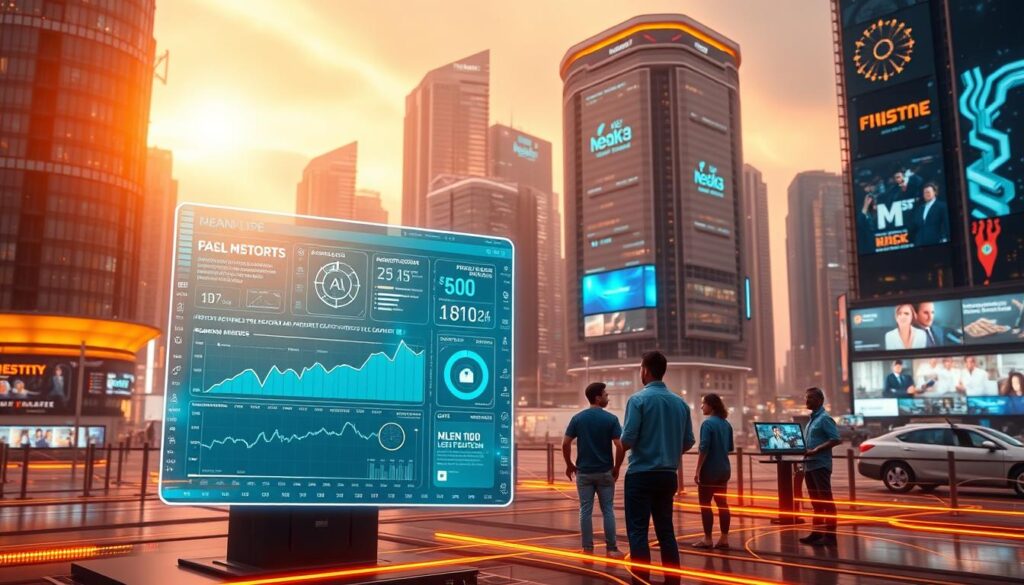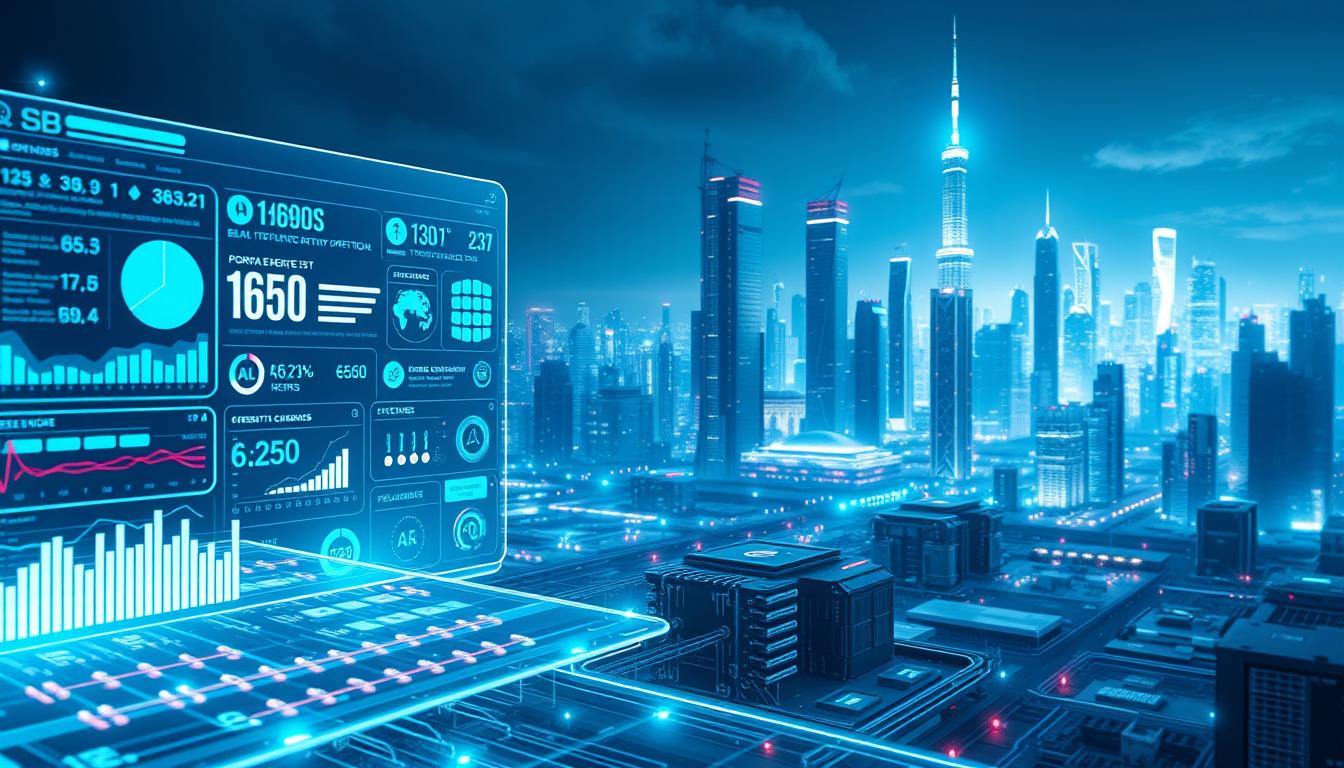Your business is at a critical turning point in digital marketing. Old ways of improving website performance are being replaced by smart systems. These systems predict what customers will do before they do it.
Recent studies show that 75% of companies using artificial intelligence for conversion rate optimization have seen big improvements. The global CRO market is growing fast, aiming for $1.8 billion by 2027. Machine learning is leading this change.
Smart businesses are moving away from old ways. They’re using AI-powered personalization strategies to analyze visitor patterns in real-time. These tools don’t just look at what happened—they predict what will happen next.
This change is more than just new tech. It’s about staying ahead when new marketing ideas are key to success. The real question is, will you lead or follow this AI revolution?
Key Takeaways
- 75% of businesses using AI-powered CRO report significant conversion improvements
- The conversion rate optimization market will reach $1.8 billion by 2027
- AI tools enable predictive customer behavior analysis in real-time
- Traditional reactive optimization methods are becoming obsolete
- Early AI adoption provides a big competitive edge
- Machine learning turns visitor data into useful insights
The Current Landscape of AI in Digital Marketing
Marketing automation and conversion AI are changing how companies reach out to customers. They’re moving away from old ways to smart, data-based methods. This change is not just a trend; it’s key for staying ahead in digital marketing.
Numbers show a clear picture. Most online shoppers are unknown, but old tools only focus on a few. This means most visitors are ignored, while a small number gets all the attention.

Market Transformation and Adoption Trends
The use of conversion AI is growing fast. Studies say 72% of companies will use AI tools in two years. This shift means moving from just reacting to creating personalized experiences.
Small and medium businesses are at the forefront. They see AI as a way to compete with bigger companies, even with smaller budgets.
Why Traditional Methods Are Falling Behind
Old methods like A/B testing and generic personalization are not working well. Gartner says 80% of marketers will give up on personalization by 2025 because of low returns.
The “CRO delusion” focuses too much on those who already buy. It overlooks the hard work and resources needed for real personalization.
| Traditional Methods | AI-Powered Approach | Impact on Results |
|---|---|---|
| Generic A/B testing | Intelligent experimentation | 3x faster optimization |
| Manual segmentation | Behavioral pattern recognition | 85% accuracy improvement |
| Static personalization | Real-time adaptation | 40% conversion increase |
| Reactive campaigns | Predictive targeting | 60% cost reduction |
AI Conversion Optimization: Technologies Driving Success
Advanced artificial intelligence systems now deliver personalized experiences by analyzing behavioral patterns faster than traditional methods ever could. These breakthrough technologies transform visitor interactions from generic experiences into revenue-generating opportunities. McKinsey research shows that personalization initiatives can drive 10-15% revenue uplift, with industry leaders seeing up to 25% improvement.

Machine Learning for Behavioral Pattern Recognition
Machine learning algorithms identify subtle visitor behaviors that indicate purchase intent, moving beyond simple demographic targeting. These ai tools analyze traffic sources, browsing patterns, and engagement signals automatically. Your systems can now understand actual shopping motivations, not just basic visitor categories.
This technology creates intelligent visitor segments without manual intervention. It processes behavioral signals in milliseconds to recognize patterns that human analysts might miss entirely.
Predictive Analytics and Customer Intent Modeling
Predictive analytics represents the next evolution in conversion optimization by anticipating visitor needs before they’re expressed. This artificial intelligence processes vast datasets to forecast which visitors are most likely to convert. You gain insights into specific actions that will drive purchase decisions.
The technology examines historical data, current behavior, and contextual factors simultaneously. This thorough analysis helps you understand customer intent with remarkable accuracy.
Real-Time Personalization at Scale
Real-time personalization addresses traditional optimization limitations by creating unique experiences for every visitor simultaneously. Unlike conventional A/B testing that requires weeks for statistical significance, ai tools adapt experiences instantly based on behavioral signals.
Leading platforms implement these technologies to achieve 25% revenue improvements through intelligent personalization strategies. These systems operate effectively without requiring cookies or invasive tracking methods, ensuring privacy compliance while maximizing conversions.
Leading AI Tools and Platforms Delivering Results
Today’s marketing automation tools, powered by AI, offer results that old methods can’t match. They change how we optimize conversions by using smart decisions and quick data processing.
Top businesses use ai tools to automate marketing tasks and keep personalization at scale. Each tool has unique strengths to tackle different conversion challenges in digital marketing.

Dynamic Experimentation with Optimizely
Optimizely changes A/B testing with smart multi-variable optimization. It can test dozens of elements at once, keeping results reliable.
The system automatically sends traffic to the best variations. This cuts down testing time from weeks to days. AI algorithms learn from visitor behavior to improve results in real-time.
You can now run complex tests that manual methods can’t handle. The platform handles stats automatically, giving you reliable results for your conversion efforts.
Conversational Solutions Through Drift
Drift’s conversational AI changes website chats with smart chatbots that qualify leads. These chatbots guide visitors through personalized buying journeys based on their needs and behaviors.
The platform gets better at responding as it learns from every chat. Your chatbots become more effective at converting visitors as they learn more about customer preferences and pain points.
Advanced natural language processing lets these ai tools handle complex questions and offer relevant solutions. This creates a personal experience that feels automated.
Content Personalization via Adobe Target
Adobe Target shows off AI for creating personalized experiences across touchpoints. It uses machine learning to find the best content, offers, and messages for each visitor segment.
Platforms like Paige create 5-7 persona segments for Meta ads, while Adobe Target personalizes your whole digital space. This approach ensures consistent messaging in the customer journey.
The system analyzes visitor behavior to predict which content will convert. Real-time personalization adjusts your website based on visitor characteristics and past interactions.
Intelligence and Insights from Google Analytics
Google Analytics Intelligence gives the analytical base for AI-driven optimization. It automatically shows insights about visitor behavior, highlighting conversion opportunities you might miss.
Predictive analytics help you see future trends based on current data. This lets you optimize proactively, not just react to your marketing automation strategies.
The system alerts you to anomalies and opportunities. You get insights on which pages, campaigns, or user segments need attention for better conversion rates.
| Platform | Primary Strength | Best Use Case | Key Benefit |
|---|---|---|---|
| Optimizely | Multi-variable Testing | Complex Experimentation | Faster Results |
| Drift | Conversational AI | Lead Qualification | 24/7 Engagement |
| Adobe Target | Content Personalization | Enterprise Solutions | Cross-channel Consistency |
| Google Analytics | Predictive Insights | Performance Analysis | Automated Reporting |
Knowing which tools fit your business needs helps you see their ROI. Think about your current conversion challenges and growth goals when picking the right AI tools for increasing conversion rates.
Proven AI Strategies Boosting Conversion Rates
Today’s top businesses use conversion ai strategies to boost their conversion rates. They cut their optimization work by 80-90% and outperform old methods. The secret is using AI to focus on key areas for improvement.
Smart Product Recommendations and Cross-Selling
Smart product recommendations are a big win for artificial intelligence in boosting sales. These systems look at what you buy, what you browse, and who you are to suggest products just when you need them.
Unlike simple “customers who bought this also bought” suggestions, today’s AI gets your unique tastes and seasonal trends. It also thinks about what’s in stock and how much profit it can make. This smart approach can significantly increase average order values and make customers happier.
Behavioral Triggers and Micro-Moment Targeting
AI is great at spotting when you really want something. If you spend a lot of time looking at product details or keep coming back to certain categories, AI knows you’re serious.
These signals let AI send you personalized messages at the perfect time. It figures out the best time, message, and offer based on who you are. Companies using this see huge jumps in sales as you move through your shopping journey.
Automated Cart Abandonment Recovery
Cart abandonment recovery has moved beyond simple emails. Today’s AI runs complex, multi-channel campaigns that change based on how you act and when you leave.
It looks at how long you’ve been gone, what you’ve bought before, and how you’ve interacted with the site. This helps it pick the best way to win you back. Automated systems work all the time, trying different approaches with thousands of people at once.
| AI Strategy | Average Improvement | Implementation Time | Workload Reduction |
|---|---|---|---|
| Smart Recommendations | 25-40% AOV increase | 2-4 weeks | 85% |
| Behavioral Triggers | 15-30% conversion lift | 3-6 weeks | 90% |
| Cart Recovery | 20-35% recovery rate | 1-3 weeks | 80% |
Implementation Roadmap for AI Marketing Automation
Your journey to using conversion AI starts with planning and execution. Success comes from a solid foundation before adding advanced features. These features can overwhelm your team or disrupt operations.
Begin by looking at where your traffic comes from. This helps you understand visitor behavior. It guides your AI strategy from the start.
Data Infrastructure and Integration Planning
Your marketing automation success depends on linking all data sources. Check your tools like website analytics, CRM, email platforms, and marketing software.
Make sure AI systems can easily access visitor data. This technical setup is key to your AI operation.
Pilot Program Development and Testing
Start with small tests in key areas like homepage personalization or product recommendations. These tests show quick, measurable results. They prove AI’s value to those who are skeptical.
Begin with simple implementations. This lowers risk and builds confidence in your marketing automation skills. Then, you can move on to more complex tasks.
Scaling and Team Training Strategies
Teach your marketing team to work with AI, not fear it. They need to understand AI insights, adjust strategies, and keep creative.
Grow gradually by adding new marketing automation features. This approach ensures a smooth transition. It also maximizes your conversion AI investment.
Performance Metrics and ROI Measurement
To get the most from your marketing automation, focus on revenue impact, not just conversion rates. Your ai tools can help increase average order values, even if conversion rates don’t change. This shows the real value of AI in personalizing your business.
Measuring success means looking beyond simple numbers to real business results. You need a detailed system that shows how AI changes customer behavior at every step.
Key Performance Indicators for AI Campaigns
Your AI campaign metrics should track more than just conversions. Revenue per visitor gives you deeper insights than conversion rates. Customer lifetime value optimization helps measure ROI over the long term.
Here are the key KPIs to focus on:
- Revenue per visitor and session value
- Customer lifetime value increases
- Engagement quality scores
- Average order value improvements
Attribution Modeling and Revenue Tracking
AI systems offer better attribution across various touchpoints and channels. They give you a full view of customer journeys, something traditional tracking can’t do. This advanced method shows how personalization affects decisions, even after the sale.
Cost-Benefit Analysis and Budget Optimization
When analyzing your marketing automation investment, compare total costs to revenue gains. Include direct costs like software and indirect costs like training time. This detailed method shows ROI and finds ways to improve business impact.
Conclusion
Conversion ai is changing the game in today’s digital world. Companies using AI in their marketing see a 20% increase in conversions. By 2030, AI could add $13 trillion to the global economy.
Your business has a big choice to make. Old ways of optimizing can’t keep up with AI’s power. AI makes every visit personal, unlike traditional methods.
Marketers know this, with 84% already using or planning to use marketing automation. They see it as a must for survival, not just growth.
Privacy laws make it hard to track visitors without AI. AI lets you create great experiences without needing lots of data. It changes how you understand and meet customer needs instantly.
Being ahead means acting now. Start with small tests to show quick wins. Build the tech needed for lasting success. Your rivals will fall behind as you lead with AI.
The AI era in conversion optimization is already here. Businesses that adopt these technologies now will lead their markets soon.

